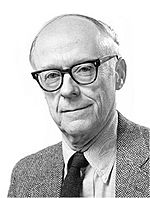William Jencks facts for kids
Quick facts for kids
William Platt Jencks
|
|
|---|---|
 |
|
| Born | August 15, 1927 |
| Died | January 3, 2007 (aged 79) |
| Alma mater | Harvard College |
| Known for | Chemical mechanisms of enzyme catalysis, his book Catalysis in Chemistry and Enzymology |
| Awards | American Chemical Society Eli Lilly Award in Biological Chemistry, National Academy of Sciences, foreign member of the Royal Society |
| Scientific career | |
| Fields | Biochemistry |
| Institutions | National Academy of Sciences Brandeis University |
| Influences | Fritz Lipmann, R. B. Woodward |
| Signature | |
 |
|
William Platt Jencks (August 15, 1927 – January 3, 2007) was an American biochemist. A biochemist studies the chemistry of living things. Jencks was famous for his work on enzymes. Enzymes are like tiny helpers in our bodies. They make chemical reactions happen faster. He used ideas from organic chemistry to understand how these enzymes work.
A Scientist's Journey
William Jencks went to Harvard College and finished in 1947. He studied English there. Later, he earned a medical degree from Harvard University in 1951. After medical school, he worked at a hospital.
He then did special research called a postdoc. He worked with a famous scientist named Fritz Lipmann for two years. Later, he joined the Army Medical Corps. He worked at a medical center in Washington, D.C. In 1956, he did another postdoc with R. B. Woodward at Harvard.
In 1957, Jencks moved to Brandeis University. He helped start a new program there for biochemistry. He taught and did research at Brandeis until he retired in 1996.
Understanding Enzymes
Much of Jencks's work focused on how enzymes act as catalysts. Catalysts are substances that speed up chemical reactions. He wanted to know the exact steps enzymes use. He studied how enzymes make reactions happen very quickly.
He was well known for his studies on how enzymes react with carbon atoms. Jencks suggested that enzymes use something called the "Circe Effect". This idea explains how enzymes can make the chemicals they work on more reactive. It's like they magically pull the chemicals into the right position to react.
He also talked about "one-way enzymes." These are enzymes that work much better in one direction than the other. His important book, Catalysis in Chemistry and Enzymology, explained many of his research ideas. Jencks wrote almost 400 scientific papers in his career.
Jencks also helped start a special meeting for scientists. It was called the Winter Enzyme Mechanisms Conference. Scientists still remember his contributions at these meetings.
Awards and Special Recognition
William Jencks received many important awards for his scientific work. In 1962, he won the American Chemical Society Eli Lilly Award in Biological Chemistry. He also received awards from the American Society of Biological Chemists.
In 1971, he was chosen to be a member of the United States National Academy of Sciences. This is a very high honor for a scientist in the U.S. It means he was one of the top scientists in the country. He was also a foreign member of the Royal Society in the UK. This is another very important science group. He was also a member of the American Philosophical Society.
About His Life
William Jencks's father, Gardner Jencks, was a talented pianist and composer. William went to the Calvert School and then to St. Paul's School for high school.
After his first year of medical school, he did research at the Marine Biological Laboratory in Woods Hole. He studied the colors in lobster shells. While at Woods Hole, he met Miriam Ehrlich, who later became his wife.
William Jencks was married to Miriam for 56 years. He had two children, Sara and David. He also had a grandson named Benjamin. His siblings were Charles Jencks, a landscape architect, Penelope Jencks-Hurwitz, and John Cheetham.

